Cool Down for Tuna
Ken Neill
Published in Chesapeake Angler
 We tend to think of the summer months as the time to fish the offshore waters of Virginia. Summer is a great time to run offshore but, for tuna, the cooler temperatures of fall provide for our best tuna action of the year. September is white marlin time. October and November belong to tuna.
We tend to think of the summer months as the time to fish the offshore waters of Virginia. Summer is a great time to run offshore but, for tuna, the cooler temperatures of fall provide for our best tuna action of the year. September is white marlin time. October and November belong to tuna.
 Yellowfin tuna are our primary target, but during the fall we may find tuna of all colors. We can find yellowfin, blackfin, bluefin, bigeye and longfin tuna all mixed together. Fall is our best time to catch longfin (albacore) tuna and when you run into these tasty creatures, they come in packs.
Yellowfin tuna are our primary target, but during the fall we may find tuna of all colors. We can find yellowfin, blackfin, bluefin, bigeye and longfin tuna all mixed together. Fall is our best time to catch longfin (albacore) tuna and when you run into these tasty creatures, they come in packs.
In general, all of the tunas feed more aggressively in  the fall. Instead of a single bite here or there that you experience in the summer, what happens during the fall feed is that all of your lines go down at once. Drags are screaming and there is a lot of yelling as you try to figure out how your four anglers are going to fight seven tuna at the same time. It is a great problem to have.
the fall. Instead of a single bite here or there that you experience in the summer, what happens during the fall feed is that all of your lines go down at once. Drags are screaming and there is a lot of yelling as you try to figure out how your four anglers are going to fight seven tuna at the same time. It is a great problem to have.
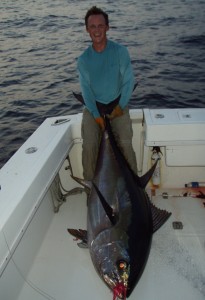 The satellite sea surface temperature services really come into their own during the fall. Look for areas where warmer water shoves into the 100-fathom curve. The edge where the cool and warmer water meet can be the dinner table where all of the tuna meet to feed. When you find this change try fishing both the cold side and the warm side until you find where the tuna are. Look for all of the other normal signs of life: birds, slicks, whales and feeding porpoise to help guide you to the bite.
The satellite sea surface temperature services really come into their own during the fall. Look for areas where warmer water shoves into the 100-fathom curve. The edge where the cool and warmer water meet can be the dinner table where all of the tuna meet to feed. When you find this change try fishing both the cold side and the warm side until you find where the tuna are. Look for all of the other normal signs of life: birds, slicks, whales and feeding porpoise to help guide you to the bite.
The tricks used during the summer to get a finicky tuna to 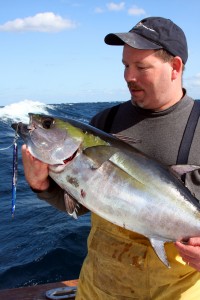 bite: light leaders, fishing baits way-way back and so on are not needed during the fall bite. We fish heavy leaders and keep our spread in close to the boat. Multiple hookups are the goal. Baits are a mixture designed to create a commotion and to get attention. Spreader bars and squid daisy chains work very well for this. Try various colors to see what is hot that day. For some reason, pink seems to work very well during the fall so it would be good to have something pink in your spread.
bite: light leaders, fishing baits way-way back and so on are not needed during the fall bite. We fish heavy leaders and keep our spread in close to the boat. Multiple hookups are the goal. Baits are a mixture designed to create a commotion and to get attention. Spreader bars and squid daisy chains work very well for this. Try various colors to see what is hot that day. For some reason, pink seems to work very well during the fall so it would be good to have something pink in your spread.
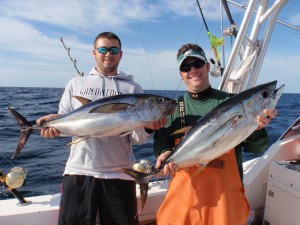 We will have a couple of large ballyhoo/Ilander combinations somewhere in the spread, trolled on heavy tackle. When the bigeye tuna wham us, we have something out there that can handle them.
We will have a couple of large ballyhoo/Ilander combinations somewhere in the spread, trolled on heavy tackle. When the bigeye tuna wham us, we have something out there that can handle them.
When you do get a bite, do not stop trolling. Give it a moment before slowing down. You can make a turn towards the side that you are hooked up on and try to get some more fish hooked up before you settle down for the fight. There are times that jigging your remaining baits can elicit more bites.
can make a turn towards the side that you are hooked up on and try to get some more fish hooked up before you settle down for the fight. There are times that jigging your remaining baits can elicit more bites.
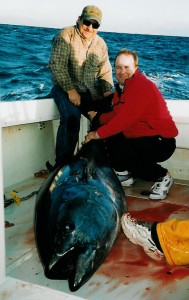 While most of our fall tuna are caught on the surface while on the troll, sometimes it pays to think deep. Fall can be an excellent time to break out the flutter jigs. If you are not getting the trolling bite but are marking fish on your bottom machine, it can be worth it to stop and try jigging the marks. There are times when the fish have bait balled up down deep and they are not interested in what is happening on the surface but a jig fluttering past their faces will produce savage strikes. You can combine trolling and jigging. When you get a troll bite and are fighting your fish, any angler not occupied can drop a jig down and start working it.
While most of our fall tuna are caught on the surface while on the troll, sometimes it pays to think deep. Fall can be an excellent time to break out the flutter jigs. If you are not getting the trolling bite but are marking fish on your bottom machine, it can be worth it to stop and try jigging the marks. There are times when the fish have bait balled up down deep and they are not interested in what is happening on the surface but a jig fluttering past their faces will produce savage strikes. You can combine trolling and jigging. When you get a troll bite and are fighting your fish, any angler not occupied can drop a jig down and start working it.
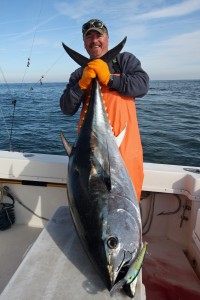 Depending on the water temperatures, this mixed-bag tuna fishery can last through November and even into December some years before the water and tuna move out of range of Virginia’s boats. When that happens, the tuna fishing is not over. We just move inshore and fish for bluefin tuna. Those guys can come right into the beach.
Depending on the water temperatures, this mixed-bag tuna fishery can last through November and even into December some years before the water and tuna move out of range of Virginia’s boats. When that happens, the tuna fishing is not over. We just move inshore and fish for bluefin tuna. Those guys can come right into the beach.
